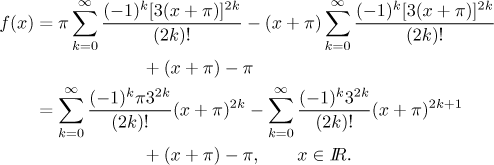Problem: Expand the given function in a power (Taylor) series with the given center:
![]()
Solution: We use the standard approach. We see that once we expand the cosine, our main work is done, the remaining parts are easy to handle. Thus the given function already has a reasonable form and we can pass to the first step, changing all x so that instead we have terms
(x − (−π)) = (x + π).
Here we go:
![]()
If we expand the cosine now, the resulting series will have terms as in its
argument and it will not be a power series with center
![]()
Now we are ready to expand the cosine using the series for

Note that the cosine expansion is valid
for every
We have the answer expressed as a sum of two power series, but it is expected that we provide one power series. Thus the last step usually is to put the two series together. Note, however, that in this particular example it would be rather unpleasant, since one series features even powers and the other odd powers, therefore there is no overlap. If we really wanted to write it as one series, we would have to put in a general coefficient ak in there and then describe its value depending on whether k is even or odd, so we would not make things easier for the reader, they might be even worse. Therefore in such a case of non-overlapping series we traditionally keep them as they are.
Here we actually should do one thing, each series has a
common term with the extra finite part, namely the power
